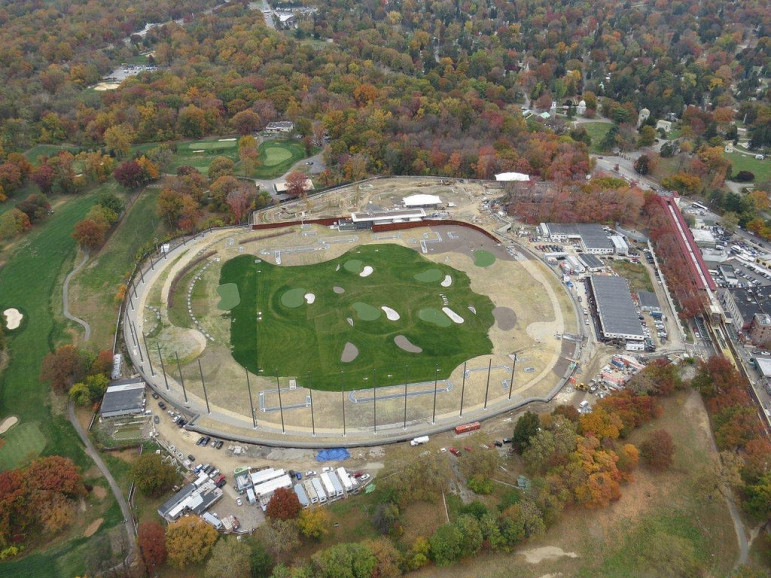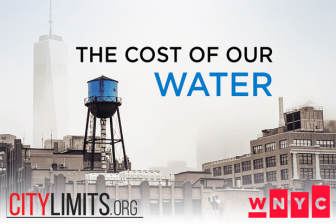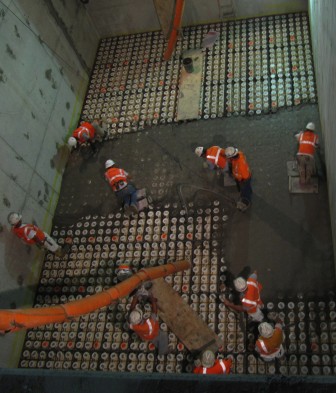
DEP
The Croton Filtration Plant will screen water from the city's east-of-Hudson watershed.
The projected seven-year construction started 11 years ago. The estimated price tag — pegged at $800 million in the late 90s and then at $992 million in 2003 — is now well over $3 billion. During that time, two opposing groups have had different words to describe the construction of the Croton Filtration Plant in the northwest Bronx.
A group of locals — including an assemblyman, grassroots organizers, non-profit founders, community board chairs and members — have used words like “boondoggle”and “scandal.”
“I suspect one day the Croton Filtration Plant will be right up there with the Tweed courthouse as far as mammoth examples of municipal waste — and possibly worse,” Assemblyman Jeff Dinowitz said in a recent interview.
City officials and commissioners of the New York City Department of Environmental Protection have criticized the federal requirement, calling it an “unfunded mandate.” But they have also defended what they have done, citing the health of New Yorkers.

All this week, a joint City Limits-WNYC reporting partnership will broadcast and publish stories about New York City's incredible water system and the challenges it faces.
“You had to build it,” said former DEP Commissioner Chris Ward. “You couldn’t jeopardize those parts of the city, primarily the Bronx, who rely on the Croton system. You couldn’t say to women in the Bronx, ‘You face a potentially spontaneous abortion, you’re facing long term cancer risks which are disproportionate to a person who lives on the Upper East Side of Manhattan.'”
The Croton Filtration Plant — amazingly built 10-stories underground in Van Cortlandt Park — is now filtering water from the Croton Watershed and sending it to taps in the Bronx and Manhattan. The 400,000 square-foot facility will supply the city with roughly 10 percent of its water under normal circumstances and up to 30 percent in times of intense need.
Large infrastructure projects in the city are always a bit messy, but with a history of fines, lawsuits, protests, cost overruns, disputed truths and accusations, the construction of the plant to filter Croton water has been one of the more controversial ever in the city. And while it’s not nearly as heated as it was in years past, the conflict continues.
A deep history
Under the 1986 update to the Safe Drinking Water Act, surface drinking water (i.e., from reservoirs as opposed to wells) is required to be filtered. Exceptions were granted if a city could prove to the feds that it could protect its water and keep it suitable for drinking. New York qualified for such an exemption in its west-of-Hudson watershed. But in its Croton watershed — located in Rockland, Putnam and Westchester counties — New York City failed to protect the water from development, at least by federal standards. And development can introduce harmful pathogens like Giardia and Cryptosporidium into drinking water.
If that watershed had been protected, the city wouldn’t need to build a plant, according Eric Goldstein, a lawyer with the Natural Resources Defense Council.
“There’s a big lesson here. The city probably could have avoided this enormous project if it had done a better job in the 1950s and 60s of safeguarding the watershed lands that surround the reservoirs from haphazard development,” he says. “The city ultimately had no choice but to build a filtration plant.”
So in 1991, the city agreed to build a filtration plant and the following year, signed a consent agreement to build the plant by 2000. The city revived a decades-old idea to build a plant on the Jerome Park Reservoir in the Bronx—what the 50,000 or so residents surrounding it affectionately call their “lake.” But the plan faced such intense opposition from those neighbors that it was abandoned, marking a victory for grassroots organizing.
Other sites were discussed, including in Van Cortlandt Park, Westchester County and along the Harlem River. In the late 90s, the Giuliani administration tried to move forward on the site it preferred, underneath the Mosholu Golf Course in Van Cortlandt Park. Since the plant would be built on city-owned parkland, the administration felt it could build as-of-right. Locals rose up against that plan as well, arguing against using parkland for an enormous facility.
“When I was growing up, we were told and taught that parkland is sacred land … Once it’s mapped as parkland it can never be touched,” says lifelong Bronxite Gary Axelbank, who hosts the call-in talk show BronxTalk on BronxNet and has been fighting against the plant since the 1990s.
The Friends of Van Cortlandt Park and New Yorkers for Parks sued the city in 2001, saying that in order to alienate parkland, even if it would be turned back into parkland after construction, the city must go to the state legislature for approval. That year, the State Court of Appeals ruled against the Giuliani administration, saying it needed Albany’s approval. The Bronx thought it won.
“At that point, many of us thought that the issue was resolved in our favor,” says Dinowitz.
A couple years later, however, the Bloomberg administration revived the plan for Van Cortlandt Park. At this point, two other locations — one in Eastview in Westchester County and another along the Harlem River in the Bronx — were considered, but the city again pushed for Van Cortlandt. During the battle over siting the plant, Bloomberg’s DEP commissioner, Chris Ward argued the Van Cortlandt site would cost $250 million less than the Eastview site, whichBronx activists pushed for. He said the Westchester site meant less redundancy for the overall water system because the DEP planned to build a UV treatment plant there. He also said that building it in Van Cortlandt meant jobs for Bronxites.
Ward approached the leader of the Bronx Democratic Party, Assemblyman Jose Rivera, asking for support for the project. To gain the backing of the Bronx Assembly delegation, Ward proposed more than $200 million in funds from the DEP to improve parks across the Bronx. And so the entire Bronx delegation, except Dinowitz, voted in favor of the project. On the last day of the 2003 legislative session in the middle of the night, a bill to temporarily alienate parkland passed the Assembly with 78 votes, two more than it needed.
Shovels hit the ground in Van Cortlandt Park in 2004.
Born to overrun
Last November, the Independent Budget Office reported the total already committed for the Croton plant and related projects was $3.539 billion, with a projection through 2020 of $3.697 billion. That includes reconstruction of the New Croton Aqueduct and parks mitigation projects; the plant itself is projected to cost $3.18 billion, more than three times original estimates.
The city has paid the EPA $6.74 million for violating its consent decree due to delays, though because the plant was up and running before the latest May deadline, the city avoided a $65 million fine.
Over the years, the DEP has said rising labor and construction costs, as well as inflation, was to blame for the overruns.
In a recent interview with WNYC and City Limits, former DEP Commissioner Ward spoke about the rising costs, saying early estimates were low. But he said other sites would have had the same rising costs.
“This project has been fraught with accusations and fraught with concerns and legitimate questions of ‘Was this done the right way?’ ‘Did it cost the right amount?’ And I stand by that it was the right decision, it was built in the right place, the Bronx benefited from it,” Ward said. “Nothing comes in under initial estimates in the public sector.”
Critics don’t buy that. They can’t fathom how building above ground on an industrial lot in Westchester would have cost more than, as Dinowitz says, digging a “hole deep enough and wide enough to throw in a couple of Yankee Stadiums.”
Ward defends the choice, saying the final cost was not due to building it underground, but rather the “size, complexity and the amount of technology associated with building this plant from its initial estimate to completion.”
“I don’t think that there is any evidence that Westchester would have been $250 million cheaper or that somehow Westchester would have been realized at a price any less than what it cost to build it in the Bronx,” Ward says.
Whatever their source, these costs have been handed down to New Yorkers through their water bills, via rates that increased 143 percent during the years it took to build this plant—though of course those bills paid for lots of other projects, too.
Questions about hiring
Critics also argue the promised economic boost was never realized.
Throughout the decade of construction, the number of Bronx workers on the site hovered around 20 percent, according to DEP reports presented to the monitoring committee. The last report City Limits was able to get from early 2013 shows the percentage of Bronx workers jumped between 15 and 19 percent in 2011 and 2012.
There was never any threshold the DEP needed to meet for hiring within the Bronx, but critics say that the promise of a significant amount of jobs for Bronxites was never fulfilled and that many of the jobs went to people from out of state.
The local hiring numbers aren’t all that different from other controversial projects in the city. Roughly 22 percent of construction jobs at Barclays Center went to Brooklynites and the Yankees promised 25 percent local hiring for constructing its new Stadium, though there is no available data to confirm whether that actually happened.
More ammunition for critics came in the form of fraud settlements against two companies working on the plant.
Schiavone and Siemens have paid millions in fines in non-prosecution agreements related to falsely reporting minority- and women-owned companies. One of those companies, Siemens, also admitted that between 2005 and 2008 it did not a master electrician on site at Croton as is required by law. M/WBE fraud is not unusual for big city projects, but in some respects this was the cherry on the top for the people looking for reasons why this was a bad project.
An incomplete promise
In 2004, Bloomberg and Governor George Pataki stood in St. James Park about a mile south of where Croton would be built to announce more than $200 million in mitigation funds for putting up with Croton construction in a park. Bloomberg said it was an “unprecedented” legacy for the Bronx and that the level of investment “has not been seen in the Bronx, or in any other borough for that matter, since the days of the WPA.”
“The investment in parks in the Bronx that I am describing does not in any way reduce what the city Department of Parks and Recreation plans to spend on capital projects in the Bronx, which this year is $44 million dollars. In fact, it more than triples the city’s commitment to the parks in this borough over the next five years,” Mr. Bloomberg continued.
The promised spending didn’t happen.
In that five year period, through 2009, $113.8 million in Croton mitigation money was spent in Bronx parks, well shy of what was promised. Today, 11 years after Bloomberg’s speech, there are still projects that have not been completed. According to the IBO, Parks still has $56.9 million to spend from the original $200 million mitigation pool. For its part, the city will end up spending about $45.6 million more than it originally promised, though that spending is planned through 2020, 16 years after Bloomberg’s presser.
Critics argue the Bronx would have gotten those projects anyway and because the money was so spread out over time, there was no boon in spending.
“I firmly believe that whatever money we got for parks improvements in the Bronx were by and large things that we may have otherwise gotten anyway,” Dinowitz says. “We shouldn’t have had to accept this project in order to get that which the people in the Bronx should have gotten.”
Ward, who cut the deal for the mitigation funds to get approval in Albany, said the Parks Department assured other city officials it could do the large number of mitigation projects.
“The Parks Department made a commitment that they could get it done. I’m not going to second-guess why some of those projects are still lingering. They money is still there and they are going to get built,” he says, adding that the current Parks Commissioner has acknowledged that capital projects are taking too long.
In 2011, Bronx Parks Commissioner Hector Aponte said the DEP made all of the funds available for the projects, but many were delayed due to unforeseen circumstances, including not having the staff to design and oversee all of the projects in the five-year time frame.
Amplifying disappoint over the parks projects is community anger over a lack of access to the Jerome Park Reservoir. Residents near the Jerome Park Reservoir hope they can channel that positivity into improvements in their neighborhood.
While residents living near the reservoir saw it was a victory that the plant wasn’t built there, a great deal of offsite construction related to Croton has taken place around the res’. Back in 2004, Ward said the DEP planned to give the public more access the reservoir and turn it into a park. In later years under Bloomberg, however, the DEP cited security concerns and has been hesitant to allow public access. DEP Commissioner Cas Holloway released a report in 2011 saying the DEP would conduct a public access pilot program after construction concluded. That may be years away because inner walls of the reservoir now need to be repaired.
Dinowitz and state Sen. Jeff Klein have introduced legislation to turn the DEP land around the reservoir into parkland, but the DEP has continued to say it’s too big of a security risk to allow anyone closer to the water.
“Balancing local concerns with this overall mission isn’t always easy or popular,” wrote DEP spokesman Gilbride. “The water in Jerome Park Reservoir is less than an hour from the tap. Restricting access is critical to protecting the health of the 8.4 million New Yorkers who rely on that drinking water. Similar precautions are taken at Hillview Reservoir in Yonkers.”
Of course, some locals don’t buy the security threat, saying two fences are not going to stop any potential attack.
“We saw, God forbid, terrorists flew airplanes into towers. You mean to tell me if they want to pollute that reservoir, this fence, these fences are going to protect the reservoir from being polluted, are you kidding me?” Axelbank says.
Communication breakdown
The DEP recently said it was fulfilling a promise it made to the community 16 years ago: to build a pedestrian bridge over the Major Deegan Expressway in Van Cortlandt Park. For years the DEP said it did not have the funds for the project, which it agreed to in a 1999 ULURP. But on May 8, DEP announced it would provide $4 million (Parks kicked in $4 million and local state elected officials kicked in another $4 million) to construct the bridge.
The fact the pedestrian bridge was funded was a sign to some activists that the DEP under de Blasio has improved.
“I don’t recall ever, ever in any point in time, seeing something positive come out of the Bloomberg administration … I think that this admin is a little more enlightened than the last one, maybe a lot more enlightened,” Dinowitz said.
The bridge was something Friends of Van Cortlandt Park has been working furiously for. They even protested along the sides of the highway a few years back. So the project was good news.
But the way it was announced, with little outreach to stakeholders, fit what some advocates say is a disturbing pattern.
“They don’t do a very good job of informing anybody,” says Friends of Van Cortlandt Park’s Executive Director Christina Taylor. “We’re an afterthought.”
Word of the bridge project came out at the same time as another press release that revealed the Croton plant had finally been activated. Yet there was no ribbon cutting, even though this was one of the biggest infrastructure projects ever completed in New York City history. There was no press conference. No tours. The plant looks impressive from photos the DEP linked to in its release, but the agency denied multiple requests by WNYC and City Limits for a visit. Local community board chairs have also asked for a tour of the site and been denied.
Ward, asked to assess lessons DEP should have learned from the Croton saga, agrees that the city did a poor job of talking about the project.
“Government has to find a better way to talk about large-scale infrastructure projects so the public does not get into this cycle of cynicism,” he said. “The way governments engage with communities now on infrastructure has to change. Transparency and [candor] in terms of the true cost of projects has to happen much, much sooner and much earlier.”
The DEP is becoming notorious for cost overruns. According to the Citizens Budget Commission (CBC), the DEP is responsible for almost 40 percent of all construction change orders at city agencies.
Rahul Jain, a senior research associate at the CBC, says that can be traced to a couple of things. First, he says, the DEP builds some of the most complex megaprojects, which are more prone to change orders. Second, he says, there are few companies capable of doing the work, which leads to a higher cost for the city. But, he says, now that Croton and the Westchester UV facility are done, the DEP will be done with mandated projects — at least for a while.
“You would hope they would learn from their mistakes,” he says. “That’s the takeaway here, if they want to reduce the cost of repairs in the future, you’d hope they are looking at taking on mandated projects earlier, or more comprehensively. And looking at ways to get ahead of some of these cost overrun issues.”
Water under the bridge?
It’s clear the two sides — the DEP and the vocal Bronx residents who continue to speak out against the DEP — are never going to agree on whether the plant would have been cheaper or easier to construct in Westchester or if the deal was good for the Bronx and Bronx parks.
The DEP is sticking with its view that the plant was a necessity. Asked if the current administration viewed the Croton project as a success or a failure, DEP spokesman Gilbride responded that the plant provides “8.4 million New Yorkers with a critical redundancy that protects the city against drought and an increase in more frequent intense storms associated with climate change.”
“While it is true that the project was mandated and construction began during a very heated market that drove costs up, the plant is now operating and will help ensure a continued reliable supply of healthy drinking water to the largest city in the nation,” he continued.
One lesson the DEP seems to have learned is they don’t want to build another plant. If the feds ever force the DEP to build a plant for the Catskill/Delaware water, which provides 90 percent of the city’s drinking water, its $10 billion estimate might not even be close given its track record on cost estimates.

DEP
An image from the Croton plant's construction. If nothing else, the enormous expense and controversy of the Bronx project has illustrated how important it is to avoid ever having to build a filtration plant for the city's larger, Catskills-Delaware system.
In a recent New York Times article, DEP Commissioner Emily Lloyd acknowledged the DEP is committed to doing what it can to appease the feds so they do not have to build another expensive plant like Croton. “She said the price tag was ‘big enough that it inspires a deep commitment to filtration avoidance’ in the future,” reads the story’s kicker.
For community members, there are some positive takeaways. When asked what can be learned from this saga, Karen Argenti, former chair of Community Board 7, founder of Friends of Jerome Park Reservoir and member of groups like the CWCWC and Bronx Council for Environmental Quality, pulled out a piece of paper she planned to pass out at a Community Board 8 meeting later that night where she was receiving a community service award for, in part, her work with Croton. The paper is titled “Jerome Park Community Accomplishments 1992-2015,” and the first in the list is “No Plant in Jerome Park Reservoir.”
Though the plant was built in a park, the fact it wasn’t built on top of the Jerome Park Reservoir was a big victory for grassroots organizing in New York City. And the community marked small victories along the way, like having the DEP reroute construction traffic so it would do the least amount of harm to residential areas.
“Don’t ever give up,” was her advice to other communities. “Read everything. Make them show you everything … and even when you lose, pick yourself up and keep going.”
City Limits coverage of the Bronx is supported by the New York Community Trust.










2 thoughts on “Croton Plant Still Stirs Anger, Questions about Water Projects”
the first step is ALWAYS MANDATE NO OVERTIME RULE….there are so many people who need jobs there really is no need to pay anyone time and a half or double time or short turnarounds or anything other than the basic weekly pay….
Pingback: Bright Lights Protect NYers from Water System Bugs: A Photo Essay | NYC Informer